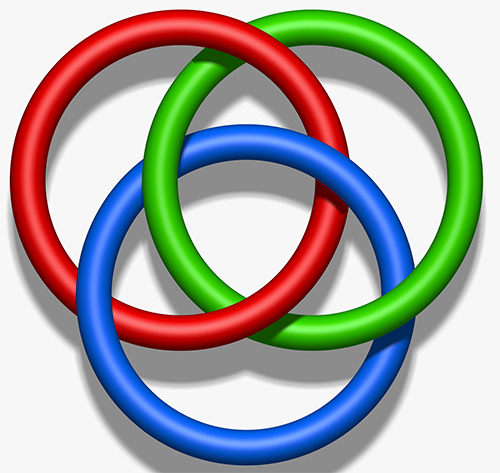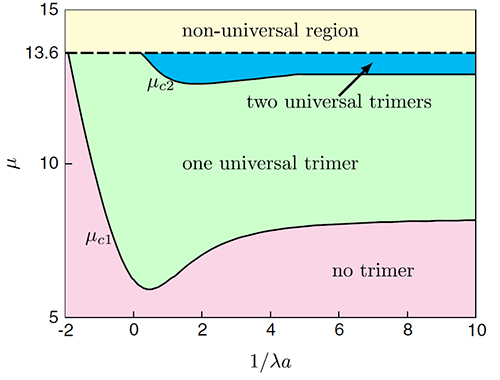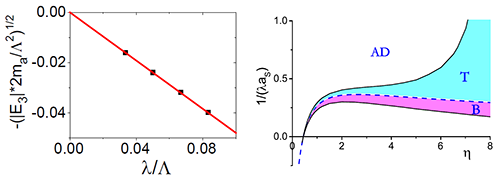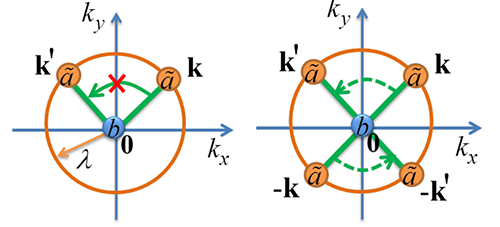Few-Body Physics in Ultracold Atoms Modified by Spin-Orbit Coupling
Date:27-08-2014 Print
Few-body problems, which have been intensively studied in Nuclear physics, now have attracted more and more attention and become a hot subject in the field of ultracold atoms. The importance of few-body physics lies in the following aspects:
On one hand, for a dilute cold atoms system, the study of few-body problems is fundamental for the establishment of the many-body Hamiltonian, and provides important hints for the property of the many-body system. Meanwhile, the study of few-body problemsis essential for therealization of scattering resonances, which give access to strongly correlated many-body systems. Practically, it also providesimportant information for the experiment to control the atom loss and prepare a stable atomic system.
On the other hand, few-body physics can exhibit its unique quantum properties. A famous example is the Efimov physics, which was predicted by a nuclear physicist Efimov in 1970, that three interacting distinguishable particles can form infinitely many bound states at the two-body scattering resonance and their binding energies follow the rule of discrete scaling invariance. This fascinating state was first verified experimentally in the cold Cesium atoms by Innsbruck group in 2006. In a more general context, the Efimov state is a special case of the Borromean rings, in which three objects are bound/linked together while any two of them is unbound/unlinked(Fig.1). This is a purely quantum effect that has rich and profound physics deep inside.
In recent years, the successful realization of spin-orbit coupling(SOC) in ultracold atoms brings up new challenges to the study of few-body physics. The challenges originate from two major effects of SOC. First, it couples scattering channels with different angular momenta, which invalidates the usual partial-wave method to treat scattering problem. Second, it effectively modifies the low-energy phase space and the density of state, therefore the particles scattering in low-energy space need to be reexamined. These two major effects no doubt will tremendously change the few-body physics, while so far little has been knownin this subject yet. Recently, Xiaoling Cui from the Institute of Physics, Chinese Academy of Sciences, together with HuiZhai and Zheyu Shi from Tsinghua University and Wei Yi from University of Science and Technology of China, has make a series of progresses in exploring the few-body physics of cold atoms with SOC:
They first consider the system of two heavy fermions interacting with a light particle which is subject to SOC. They find that due to the coupling between scattering channels with different angular momenta, the ground state energy of the three-body system is further lowered compared to the case without SOC. This leads to the occurrence of trimer state for a broad parameter regime of mass ratio and interaction strength(Fig.2). The occurrence of these trimer states is accompanied with the scattering resonance between the atom and the dimer, which renders SOC an efficient tool to control the scattering resonance and should significantly influence the property of the many-body system, as well as its three-body lossrate and the stability. This work has been published in Phys. Rev. Lett.112, 013201 (2014).
Further investigation by the authors shows that SOC can even induce trimers without the existence of dimers, which is the so-called Borromeanbinding(Fig.1). This can be achieved in a three-body system where two fermions are subject to SOC with high symmetry(such as the Rashba type). Different from the Borromeanbinding studied in literature, here its occurrence does not rely on the details of the two-body interaction potential, but only on the s-wave scattering length and the SOCstrength. Therefore they are all universal(Fig.3). This is the first study of Borromean state that exhibits the universal property, which greatly facilitates the detection of such peculiar state in experiments. Intrinsically it is due to the fact that the SOC greatly enhances the low-energy phase space of three-body scattering but suppresses that of two-body scattering. Therefore a three-body system is easier to be bound together than the two-body one. Consequently, it suggests the three-body correlation more dominated than the two-body correlation, so that more intriguing quantum phase may emerge in a many-body system. Moreover, this study reveals the key role played by the single-particle spectral symmetry in few-body physics, and sheds light on the exotic few-body correlation in a general physical system. This work has been published recently in Phys. Rev. X 4, 031206 (2014), and also highlighted in Physics (see following links).
These studies are in part supported by NSFC and CAS
Link: http://dx.doi.org/10.1103/PhysRevLett.112.013201
http://dx.doi.org/10.1103/PhysRevX.4.031026
http://physics.aps.org/synopsis-for/10.1103/PhysRevX.4.031026
 |
| Fig.1: Borromean ring. Only three objects are bound/linked together while any two of them is unbound/unlinked. |
 |
| Fig.2:Phase diagram of trimer states as functions of the mass ratio (y-axis), the SOC strength and s-wave scattering length(x-axis). The ground state is the atom-dimer state in pink regime and trimer state otherwise. In comparison with the case without SOC, here the trimer state can occur as a ground state with smaller mass ratios and negative scatterng lengths. |
 |
| Fig.3: (Left) Trimer binding energy as functions of the cutoff momentum. The linear fit shows that it does not depend on the high-energy cutoff, therefore the trimer is universal against details of short-range interaction potentials. (Right)Phase diagram of trimer states as functions of the mass ratio (x-axis), the Rashba SOC strength and s-wave scattering length(y-axis). Here “B”denotes the Borromean state,“T”the trimer state in the presence of dimers, and“AD”the atom-dimer state. |
 |
| Fig.4: Schematics of the Borromean binding mechanism. The orange circle denotes the U(1) ground state degeneracy of a-atom with Rashba SOC. The b-atom stays at zero momentum as ground state. For the two-body scattering of a-b system (left), the scattering between different momenta on the circle is forbidden, due to the conservation of total momentum; on the contrary, for the three-body scattering of a-a-b system (right), the scattering between different momenta on the circle is allowed. This shows that the phase space of the low-energy scattering of three-body is much larger than that of the two-body, thereby giving rise to the occurrence of Borromean binding. |

